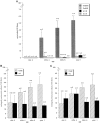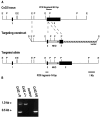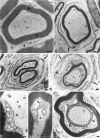Structural abnormalities and deficient maintenance of peripheral nerve myelin in mice lacking the gap junction protein connexin 32
- PMID: 9169515
- PMCID: PMC6573343
- DOI: 10.1523/JNEUROSCI.17-12-04545.1997
Structural abnormalities and deficient maintenance of peripheral nerve myelin in mice lacking the gap junction protein connexin 32
Abstract
Mutations affecting the connexin 32 (Cx32) gene are associated with the X-linked form of the hereditary peripheral neuropathy Charcot-Marie-Tooth disease (CMTX). We show that Cx32-deficient mice develop a late-onset progressive peripheral neuropathy with abnormalities comparable to those associated with CMTX, thus providing proof of the critical role of Cx32 in the maintenance of peripheral nerve myelin and an animal model for CMTX. Frequently observed features include abnormally thin myelin sheaths, cellular onion bulb formation reflecting myelin degeneration-induced Schwann cell proliferation, and enlarged periaxonal collars while nerve conductance properties are altered only slightly. These observations are consistent with earlier hypotheses suggesting a function of Cx32 as a channel-forming protein that facilitates the communication between the abaxonal and adaxonal aspects of Schwann cell cytoplasm.
Figures



References
-
- Adlkofer K, Martini R, Aguzzi A, Zielasek J, Toyka KV, Suter U. Hypermyelination and demyelinating peripheral neuropathy in PMP22-deficient mice. Nat Genet. 1995;11:274–280. - PubMed
-
- Bergoffen H, Scherer SS, Wang S, Oronzi-Scott S, Bone L, Paul DL, Chen K, Lensch MW, Chance PF, Fischbeck KH. Connexin mutations in X-linked Charcot–Marie–Tooth disease. Science. 1993;262:2039–2042. - PubMed
-
- Britz-Cunningham SH, Shah MM, Zuppan CW, Fletcher W. Mutations of the Connexin 43 gap-junction gene in patients with heart malformations and defects of laterality. N Engl J Med. 1995;332:1323–1329. - PubMed
-
- Bruzzone R, Ressot C. Connexins, gap junctions, and cell–cell signalling in the nervous system. Eur J Neurosci. 1997;9:1–6. - PubMed
-
- Bruzzone R, White TW, Scherer SS, Fischbeck KH, Paul DL. Null mutations of connexin 32 in patients with X-linked Charcot–Marie–Tooth disease. Neuron. 1994;13:1253–1260. - PubMed
Publication types
MeSH terms
Substances
LinkOut - more resources
Full Text Sources
Other Literature Sources
Molecular Biology Databases
Miscellaneous
